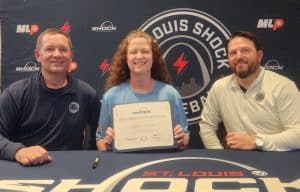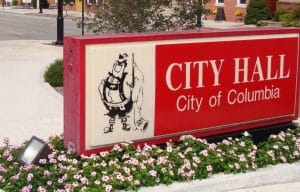Revolutionary War veteran honored at Waterloo cemetery
Although he remains buried on his rural Maeystown farm, a plaque honoring the service of Revolutionary War soldier James McRoberts was dedicated in his memory Saturday afternoon at Moore Cemetery in Waterloo, which is located just south of the Bellefontaine House along the old Kaskaskia-Cahokia Trail.
“May we never forget those who fought for the freedom of their new country,” Daughters of the American Revolution Illinois State Chaplain Ellen Crump said to conclude her invocation.
Other Revolutionary War heroes are buried at Moore Cemetery, which sits surrounded by farmland off Market Street near what was once known as Breezy Hill. Captain John Whiteside and Captain James Moore are buried there.
Whiteside Station Chapter DAR historian Florence Mulligan explained to those gathered at the ceremony that Moore Cemetery conducted burials from the 1780s to the late 1880s.
This area was the county of Virginia following the Revolutionary War, Mulligan said, and many soldiers were given plots of land to live on as compensation for their patriotic service.
“It was a long, hard way for them to go,” Mulligan said.
According to historical sources, McRoberts was born in 1763 near Glasgow, Scotland, and came to Philadelphia, Pa., in the 1770s at the age of 12.
Living in Pennsylvania at the time war broke out, McRoberts volunteered for service and was not drafted. He served under Captain Hogelin, Captain Ogles and Colonel Williamson, all under orders from Colonel John Gibson at Fort Pitt, continuing to participate to the close of the war.
During his service, McRoberts provided his own horse, gun, ammunition and, many times, his own provisions, Mulligan said. He served in his local community militia against attacks by the Delaware and Mingo Indians.
McRoberts is said to have first arrived in Kaskaskia in 1786 and later settled on a plot of land located about a mile north of what is now Maeystown. This was the site of his home for nearly 50 years.
McRoberts married Mary Fletcher Harris in 1792 and died Feb. 10, 1844.
With the dedication of a marker in memory of this proud Revolutionary War hero, the local DAR officials and Sons of the American Revolutionary officials hope to instill pride and heritage for generations to come.
A reception followed at Bellefontaine House, with attendees walking back from the cemetery along the old Kaskaskia-Cahokia Trail that was traveled by ancestors many years ago.






